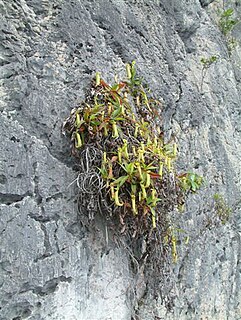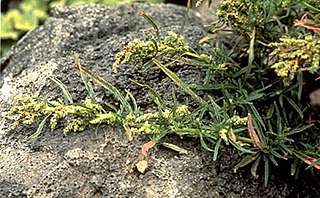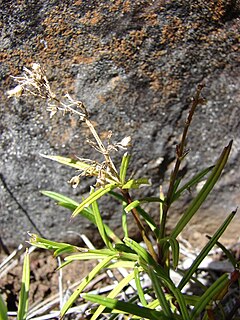
Lithophytes are plants that grow in or on rocks. Those that grow on rocks are also known as epipetric or epilithic plants. Lithophytes that grow on land feed off nutrients from rain water and nearby decaying plants, including their own dead tissue. Chasmophytes grow in fissures in rocks where soil or organic matter has accumulated.

In ecology, a habitat is the type of natural environment in which a particular species of organism lives. It is characterized by both physical and biological features. A species's habitat is those places where it can find food, shelter, protection and mates for reproduction.

Schiedea verticillata, known as the Devils Slide schiedea or Nihoa carnation, is an endangered species of plant in the family Caryophyllaceae, endemic to the island of Nihoa in the Northwestern Hawaiian Islands, where it was discovered in 1923 by the Tanager Expedition. It has been listed as endangered since 1996.

Amaranthus brownii was an annual herb in the family Amaranthaceae. The plant was found only on the small island of Nihoa in the Northwestern Hawaiian Islands, growing on rocky outcrops at altitudes of 120–215 m (394–705 ft). It was one of nine species of Amaranthus in the Hawaiian Islands, but was the only endemic Hawaiian species of the genus. It was first discovered during the Tanager Expedition in 1923 by botanist Edward Leonard Caum. A. brownii differed from other Hawaiian species of Amaranthus with its spineless leaf axils, linear leaves, and indehiscent fruits.

Schiedea adamantis, commonly known as Diamond Head schiedea, is a species of flowering plant in the family Caryophyllaceae, that is endemic to the island of Oʻahu in Hawaii. It inhabits low shrublands on steep slopes along the northwest rim of Diamond Head Crater. Associated plants include nehe, kāwelu, ʻakoko, and ʻilima. There are only about 30 individuals remaining, and they are threatened by habitat loss.

Schiedea is a genus of flowering plants in the family Caryophyllaceae. It contains 34 species and is endemic to Hawaii.

Schiedea kaalae, known as Oahu schiedea or Maʻoliʻoli in Hawaiian, is a species of flowering plant in the family Caryophyllaceae, that is endemic to the island of Oʻahu in Hawaii. It inhabits coastal mesic and mixed mesic forests at elevations of 210–790 m (690–2,590 ft) in the Koʻolau and Waiʻanae Ranges. It is threatened by habitat loss.
Schiedea apokremnos is a rare species of flowering plant in the family Caryophyllaceae known by the common names Kauai schiedea, Na Pali Coast schiedea, and ma`oli`oli. It is endemic to Hawaii, where it is known only from the island of Kauai. It is threatened by the degradation of its habitat. It is a federally listed endangered species of the United States.
Schiedea attenuata is a rare species of flowering plant in the family Caryophyllaceae known by the common name Kalalau schiedea. It is endemic to Hawaii, where it is known only from the Kalalau Valley on the island of Kauai. It is threatened by the degradation of its habitat. It was federally listed as an endangered species of the United States in 2010.

Schiedea haleakalensis is a rare species of flowering plant in the family Caryophyllaceae known by the common name Haleakalā schiedea. It is endemic to Hawaii, where it is known only from Haleakalā National Park on the island of Maui. It is threatened by the degradation of its habitat. It was federally listed as an endangered species of the United States in 1992.
Schiedea helleri is a rare species of flowering plant in the family Caryophyllaceae known by the common names Heller's schiedea and Kaholuamanu schiedea. It is endemic to Hawaii, where it is known only from the island of Kauai. It is threatened by the degradation of its habitat. It was federally listed as an endangered species of the United States in 1996.

Schiedea hookeri is a rare species of flowering plant in the family Caryophyllaceae known by the common names Hooker's schiedea and sprawling schiedea. It is endemic to Hawaii, where it is known only from the island of Oahu. It is thought to have been extirpated from Haleakalā on Maui. It is threatened by the degradation and destruction of its habitat. It was federally listed as an endangered species of the United States in 1996.
Schiedea kauaiensis is a rare species of flowering plant in the family Caryophyllaceae known by the common name Kauai schiedea. It is endemic to Hawaii, where it is known only from the island of Kauai. It is threatened by the degradation and destruction of its habitat. It was federally listed as an endangered species of the United States in 1996.
Schiedea kealiae is a rare species of flowering plant in the family Caryophyllaceae known by the common name Waianae Range schiedea. It is endemic to Hawaii, where it is known only from the Waianae Range on the island of Oahu. It is threatened by the degradation and destruction of its habitat. It was federally listed as an endangered species of the United States in 1996.
Schiedea lydgatei is a rare species of flowering plant in the family Caryophyllaceae known by the common name Kamalo Gulch schiedea and Pacific schiedea. It is endemic to Hawaii, where it is known only from the island of Molokai. It is threatened by the degradation and destruction of its habitat. It is a federally listed endangered species of the United States.

Schiedea membranacea is a rare species of flowering plant in the pink family known by the common name papery schiedea and membranous schiedea. It is endemic to Hawaii, where it is known only from the island of Kauai. It is threatened by the degradation and destruction of its habitat. It is a federally listed endangered species of the United States.
Schiedea membranacea is a rare species of flowering plant in the family Caryophyllaceae known by the common name valley schiedea. It is endemic to Hawaii, where it is known only from the island of Oahu. It has been extirpated from Maui and Molokai. Plants in a population known from Kauai are actually members of other species. Thus, the species is now endemic to Oahu. It is threatened by the degradation and destruction of its habitat. It is a federally listed endangered species of the United States.
Schiedea sarmentosa is a rare species of flowering plant in the family Caryophyllaceae known by the common name cliff schiedea. It is endemic to Hawaii, where it is known only from the island of Molokai. It is threatened by the degradation and destruction of its habitat. It is a federally listed endangered species of the United States.
Schiedea spergulina is a rare species of flowering plant in the family Caryophyllaceae known by the common name canyon schiedea and spreading schiedea. It is endemic to Hawaii, where it is known only from the island of Kauai. It is threatened by the degradation and destruction of its habitat. There are two varieties of this plant, one federally listed as an endangered species of the United States, and the other listed threatened.

Hybanthus stellarioides, commonly known as spade flower is an annual herb of the genus Hybanthus, native to Australia.











